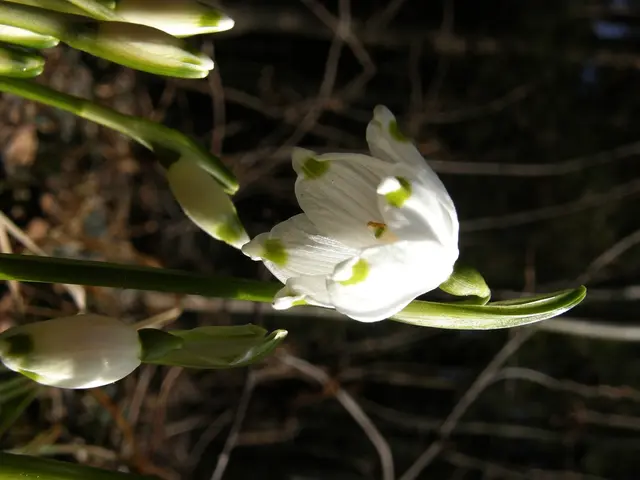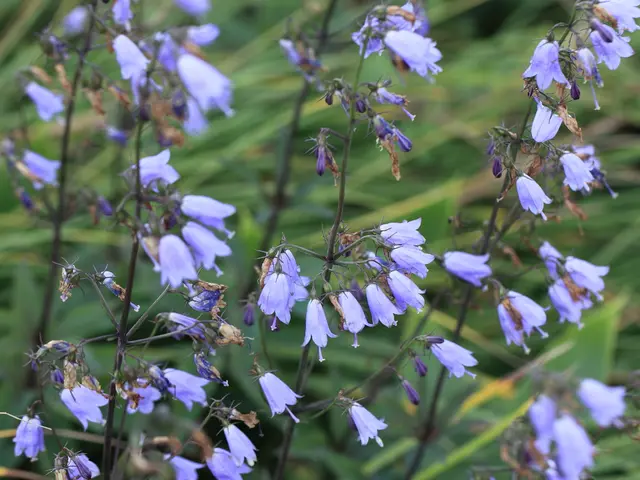Lasting pleasure through planting: Alan Titchmarsh discusses the enchantment of the agapanthus plant
Agapanthus, often known as the African lily or Lily of the Nile, is a plant that weaves its way into one's affections over a period of years. Originating from Africa, notably the species Agapanthus africanus, these plants have found a home in British gardens since the 17th century [1].
Famed gardener, writer, and broadcaster, Alan Titchmarsh, describes Agapanthus as a group of plants with striking architectural flower heads. These exotic blooms add sculptural interest to gardens, with a long flowering season that often continues through the height of summer [1].
While the original African species was only marginally hardy in temperate climates, the newer hybrids like the "Ever Panthers" have greatly improved hardiness and garden performance. These modern hybrids combine strong frost tolerance, able to withstand temperatures as low as -12 to -14 °C, with durable growth, making Agapanthus very reliable perennials in gardens subject to cold winters [1].
The 'Everpanthus Series', such as 'Ever White' and 'Midnight Sky', are particularly suitable for containers and spaces with limited area. These varieties have an extended flowering season from July to September, providing a spectacular and elegant welcome when planted in large pots at either side of a door or gateway [2].
Agapanthus come in various shades of blue, including 'black' (not quite), 'Lady Grey', and pure white. There are about 10 species of Agapanthus, but most modern hybrids are derived from crosses involving Agapanthus praecox, A.campanulatus and A. africanus [3].
It is recommended to mulch Agapanthus generously in autumn if there is doubt about their survival in a particular locale [4]. Agapanthus will last for several years in John Innes No.3 peat-free compost before needing repotting [5].
If you're looking for a gardening-related book, Alan Titchmarsh's 'Chatsworth: The gardens and the people who made them' is currently available for purchase. Published by Ebury, this book costs £35 [6].
Agapanthus can now be grown outdoors in all but the coldest locations, in sunny spots and well-drained soil [7]. So, whether you're a seasoned gardener or a novice, consider adding Agapanthus to your garden for a touch of exotic beauty.
References: 1. Titchmarsh, A. (n.d.). Agapanthus. Retrieved from https://www.alantitchmarsh.com/gardening-advice/agapanthus 2. Titchmarsh, A. (n.d.). Everpanthus Series. Retrieved from https://www.alantitchmarsh.com/gardening-advice/everpanthus-series 3. Titchmarsh, A. (n.d.). Agapanthus Varieties. Retrieved from https://www.alantitchmarsh.com/gardening-advice/agapanthus-varieties 4. Titchmarsh, A. (n.d.). Agapanthus Care. Retrieved from https://www.alantitchmarsh.com/gardening-advice/agapanthus-care 5. Titchmarsh, A. (n.d.). Agapanthus Repotting. Retrieved from https://www.alantitchmarsh.com/gardening-advice/agapanthus-repotting 6. Amazon (n.d.). Chatsworth: The gardens and the people who made them. Retrieved from https://www.amazon.co.uk/Chatsworth-gardens-people-who-made-them/dp/0091958361 7. RHS (n.d.). Agapanthus. Retrieved from https://www.rhs.org.uk/plants/34972/Agapanthus/details
Agapanthus, a plant originating from Africa, not only thrives in British home-and-garden settings but also adds a touch of exotic lifestyle to these outdoor spaces through their architectural flower heads and long flowering season. With the development of more cold-tolerant hybrids like the "Ever Panthers," growing Agapanthus has become a versatile gardening option, even in limited home-and-garden spaces such as containers.




